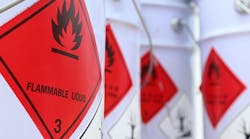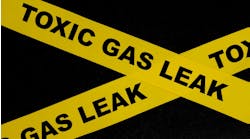Understand The Key Changes In NFPA 30
Since 1913, the National Fire Protection Association (NFPA), Quincy, Mass., has published “NFPA 30: Flammable and Combustible Liquids Code.” This document has served as the leading information source for safe handling and storage of flammable and combustible liquids. It is a recognized and generally accepted good engineering practice (RAGAGEP) that’s widely used in the field of risk management and applied by government authorities, emergency responders and end users to ensure safe storage and handling of liquids. Most state and regional codes are based on NFPA 30.
Proper use and application of NFPA 30 is a key part of an effective loss control engineering program that ensures:
• correct selection and use of containers for storage of liquids;
• appropriate and effective fire protection for storage areas;
• safe practices for dispensing, transferring, handling and use of liquids; and
• sound methods for tank storage and piping systems, including bulk loading and unloading operations.
NFPA 30 is updated through an open, consensus-based process that occurs approximately every three years. Each revision cycle proceeds according to a published schedule and offers several opportunities for the public to provide input and commentary for changing, updating and improving the standard [1].
What’s New
In 2021, NFPA adopted an updated version of the code; it can be viewed online at www.NFPA.org/30. The new edition retains the structure and chapter architecture of the 2018 standard. To address continued challenges in liquid risk management and resolve technical issues presented by new containers and storage configurations, the code incorporates six technical changes. Two additional significant changes were proposed but reversed during the consensus process. Details of the adopted and proposed/reversed changes follow, starting with the six adopted changes.
1. Flammable and combustible liquid nomenclature. Throughout NFPA 30 (2021), any liquid that has a flash point is termed “ignitable (flammable or combustible).” When referring to a specific type of ignitable liquid, NFPA 30 uses liquid class to denote boiling point and flash point ranges.
This nomenclature change decreases the use of the terms “flammable” and “combustible” to reduce confusion of terminology arising from the varying definitions applied by agencies and the globally harmonized system (GHS). For example, the U.S. Occupational Safety and Health Administration (OSHA) sets 140°F (60°C) as the delineation between flammable and combustible liquid classification, whereas NFPA specifies 100°F (37.8°C). Use of liquid class provides consistency in evaluating any liquid with a flash point. Because any liquid with a flash point can burn given a sufficient ignition source and, therefore, can be termed an ignitable liquid, the classification (e.g., Class I, Class II and Class III) provides perspective on the relative ease of ignition.
2. Treatment of beverages, medicines and other consumer products containing not more than 20% water-miscible liquids. The 2018 edition of NFPA 30 excluded from coverage any beverages, medicines, foodstuffs, cosmetics and other consumer products containing not more than 50% by volume of water-miscible flammable or combustible liquids so long as the remainder of the product consisted of components that do not burn. This exception applied to liquids in containers not exceeding 1.3 gal (5 L) [2].
Additional fire testing data were presented to support the reduction of this exclusion to not more than 20% by volume of water-miscible liquid. The 2021 edition provides specific protection coverage or the storage can be treated as unprotected.
3. Improvements to application flowcharts and new fire protection design options. Chapter 16 (Protected Storage) provides specifications for the design and configuration of automatic fire protection systems for all inside storage of ignitable liquids in containers, intermediate bulk containers (IBCs) and portable tanks that are used in accordance with the container requirements specified in Section 9.4. Liquids protected in accordance with the requirements of this chapter are considered protected storage. Protected storage allows for virtually unlimited quantities in the protected configuration.
Commercial use and development of liquids continues to drive the need for new containers and configurations of storage, which require careful evaluation with regard to effective fire protection design.
Significant additions to this chapter include:
• Three new protection schemes for small (<1 gal; 3.7 L) containers of alcohols and 50/50 alcohol/water mixtures now appear in Section 16.5.• New sections 16.5.2.13 and 16.6.5 add in-rack protection criteria for Class II liquids in metal containers using K25.2 extended coverage sprinklers.• New section 16.5.2.14 provides new fire protection criteria for liquids with flash points less than 200°F (93°C) in cartoned, 2-oz plastic bottles.• New sections 16.5.2.15 and 16.6.4 give sprinkler protection criteria for liquids with flash points greater than or equal to 450°F (232°C).4. Flammable liquid cabinet self-closing doors (Section 9.5.3). All new flammable liquid storage cabinets must have self-closing doors. This update is not retroactive, applying only to new, not existing, cabinets. It resolves conflicts with other model fire and safety codes.
5. Anchoring of tanks (Section 22.5.3). This section was added to specify the conditions where anchorage of tanks is required, making the consideration method for anchorage explicit and detailed.
6. Metallic/non-metallic composite piping (Section 27.4.7). An added subsection covers such piping, which has been in use for 20 years with a variety of flammable liquids. The composite piping system consists of an inner metallic liquid-conducting tube and an outer non-metallic tube that contains any leakage from the inner metallic tube. Monitoring the space between the inner and outer tubes for pressure can provide a way to detect leakage.
Proposed But Not Implemented
Two significant changes were reversed during the consensus process:
1. Composite intermediate bulk containers (Chapter 9). The fire risks presented by composite IBCs storing combustible liquids are well documented in the literature [3]. Additional restrictions on the use of composite IBCs were proposed but subsequently removed, with requirements reverting to those in the 2018 edition.
The current requirements for use and storage of composite IBCs are:
• Composite IBCs are not authorized for the storage of Class I liquids, except in specific limited situations detailed in Section 9.1.4.
• Composite IBCs containing a Class II or Class IIIA liquid must be listed and labeled. Units not listed and labelled are prohibited.
• Addition of requirements for conducting a hazard analysis and implementing a lower threshold for maximum allowable quantities that can be staged to Section 18.5.4.1, which details allowances for storage of liquids in incidental-use applications. It reduces the number of composite IBCs that can be temporarily staged in an operational area.
2. Exhaust ventilation credit reductions (Section 17.11). During the first revision, a decrease to 50% from 75% in the maximum credit possible for required ventilation available from local exhaust ventilation (LEV) was proposed based on concerns about ventilation compromise that could exist by improper use of LEV equipment. This was reversed during the Technical Committee’s work on the second draft, restoring the maximum 75% credit.
What Does This Mean For My Operations?
While NFPA 30 is a widely used RAGAGEP, local and state adoption of the code varies extensively. Often, the adopted version is from previous revision cycles and is augmented by local amendments.
When faced with a local adoption of NFPA 30, it is essential you have access to both the relevant edition of NFPA 30 as well as a copy of any amendments. This information is necessary to ensure compliance of current operations and new projects. Typically, when a jurisdiction has adopted an older version of NFPA 30 and you desire to use features from newer editions, variance procedures exist.
OSHA 1910.106 (Flammable Liquid Standard) is based on the 1969 edition of NFPA 30. In 1995, OSHA produced a letter of interpretation that allowed facility owners to use a more-current version in lieu of the older requirements in 1910.106 [4]. OSHA states it will accept later editions of consensus codes, such as NFPA 30, when those editions set forth requirements that are as protective as the current requirements in the standard. In such situations, the company has the burden of proof to demonstrate the measures implemented are equivalently protective.
The two changes proposed but not adopted address issues that businesses should consider. If combustible liquids are stored in composite IBCs, a review of the literature and the proposed technical changes is warranted. Also, assess whether ventilation deficiencies may exist as the result of improper use of LEV equipment.
Work already has started on updates for NFPA 30, 2024 edition, which will feature additional advancements in ignitable-liquid loss prevention. All stakeholders in the industry are encouraged to review proposed updates included in the first draft of the next edition of NFPA 30(2024) by visiting www.NFPA.org/30 and clicking the “Next Edition” tab. The First Draft Report, including final actions taken on the public inputs, is scheduled for publication by March 22, 2022. Public comment on it is due by May 31, 2022.
MIKE SNYDER, PE, CSP, CFPS, is Auburn, Mich.-based vice president, operational risk management practice for DEKRA Process Safety. Email him at [email protected].
REFERENCES
1. “NFPA 30: Flammable and Combustible Liquid Code,” National Fire Protection Association, Quincy, Mass. (2018), www.nfpa.org/30.
2. “NFPA 13: Standard for the Installation of Sprinkler Systems,” National Fire Protection Association, Quincy, Mass. (2019), www.nfpa.org/13.
3. Snyder, M. D., “Understand the Risks of Composite Intermediate Bulk Containers,” Chem. Eng. Progr., pp. 39–43, Feb. 2019.
4. “Compliance with NFPA 30 Revisions in lieu of 1910.106,” U. S. Dept. of Labor, Washington, D.C. (1995), retrieved from www.osha.gov/laws-regs/standardinterpretations/1995-07-18.


